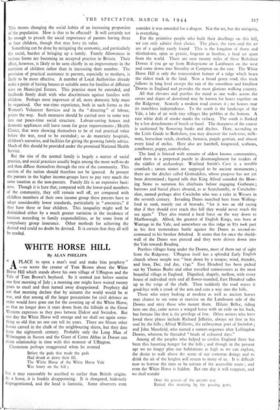WHITE HORSE HILL
By ALAN PHILLIPS horses carved in the chalk of the neighbouring shires, but they date from the eighteenth century. Probably only the Long Man of Wilmington in Sussex and the Giant of Cerne Abbas in Dorset can claim relationship in time with this monster of Uffington.
Chesterton perhaps exaggerated when be averred Before the gods that made the gods Had drunk at dawn their fill, The White Horse of the White Horse Vale Was hoary on the hill ; but it may reasonably be ascribed to earlier than British origins. As a horse, it is frankly disappointing. It is elongated, hideously disproportioned, and the head is fantastic. Some observers even consider it was intended for a dragon. Not the art, but the antiquity, is everything.
For the primitive people who built their dwellings on this hill, we can only admire their choice. The place, the view .and the air are of a quality rarely found. This is the kingdom of thorn and thistledown, open as prairie, fragrant as heather, a land set apart from the world. There are over twenty miles of these Berkshire Downs if you go up from Bishopstone or Lambourn on the west and come down into Streatley or Compton on the cast. The White Horse Hill is only the transcendent feature of a ridge which bears the oldest track in the land. Now a broad green road, this track follows in long level sweeps the run of the smoothest and kindliest °Downs in England and provides the most glorious walking country.
All that elevates and purifies the mind as one walks across . the crests and slopes of downland may be known for hours together on the Ridgeway. Scarcely a modern road crosses it ; no houses mar its matchless independence. To the north is the landscape of the Vale, a lake of air with tiny villages like pebbles at the bottom. A rare white drift of smoke marks the railway. The south is flanked by a few detachments of beech or hazel. The sharpness of the course is cushioned by flowering banks and ditches. Here, according to the Little Guide to Berkshire, you may discover the rock-rose, milk- wort, horseshoe vetch, charlock, fumaria, purple gentian, and almost every kind of orchis. Here also are harebell, knapweed, scabious, cornflower, poppy, convolvulus.
The land is littered with remains of oldest known communities, and there is a perpetual puzzle in disentanglement for readers of the riddles of archaeology. Wayland Smith's Cave is a notable cromlech ; sarsen stones are supposed to be ancient monuments ; there are the ditches called Grimsdyles, whose purpose has not yet been determined ; legend tells that King Alfred sounded the Blow- ing Stone to summon his chieftains before engaging Guthrum ; barrows and burial places abound, as at Scutchamfly, or Cwichelm- slaw, named perhaps after Cwichelm who was a ruler in Wessex in the seventh century. Invading Danes marched here from Walling- ford in mob, mainly out of bravado, "for it was an old saying that if they should ever reach this hill they would never reach the sea again." They also routed a local force on the way down to Marlborough. Alfred, the greatest of English Kings, was born at Wantage in the Vale, and somewhere on this ridge in 871 took part in his first tremendous battle against the Danes as second-in- command to his brother Athelred. It seems that for once the shield- wall of the Danes was pierced and they were driven down into the Vale towards Reading.
Peerless villages hang under the Downs, most of them out of sight from the Ridgeway. Uffington itself has a splendid Early English church whose steeple was "beat down by a tcmpas, wind, thunder, and liten, Dec. 2nd day, 1740." East Hendred has been picked out by Thomas Burke and other travelled connoisseurs as the most beautiful village in England. Dignified, shapely, mellow, with every house of individual style and all flower-mantled, East Hendred sidles up to the verge of the chalk. Then suddenly the road waves it good-bye with a crook of the arm and cuts a way into the hills.
Those who enjoy looking at modern as well as ancient horses may chance to see some at exercise on the Lambourn side of the Downs and envy those who mount them. Hilaire Belloc, riding here one day, came across a winged horse with an exile on his back, but fortune like that is the privilege of few. Other writers who have loved these places include Richard Jefferies, always set free in his soul by the hills ; Alfred Williams, the railwayman poet of Swindon ; and John Masefield, who named a sonnet-sequence after Lollingdon Downs, whereon he threaded "beads of coloured days."
Among all the peoples who helped to civilise England there has been this haunting hunger for the hills ; and though in the present age we no longer plan our habitations as high as we can explore, the desire to walk above the scene of our common doings and to drink the air of the heights will return to many of us. It is difficult now to borrow the time or be certain of the accessible route ; and even the White Horse is hidden. But one day it will reappear, and we shall wander
Over the grasses of the ancient way Rutted this morning by the passing guns.


























 Previous page
Previous page